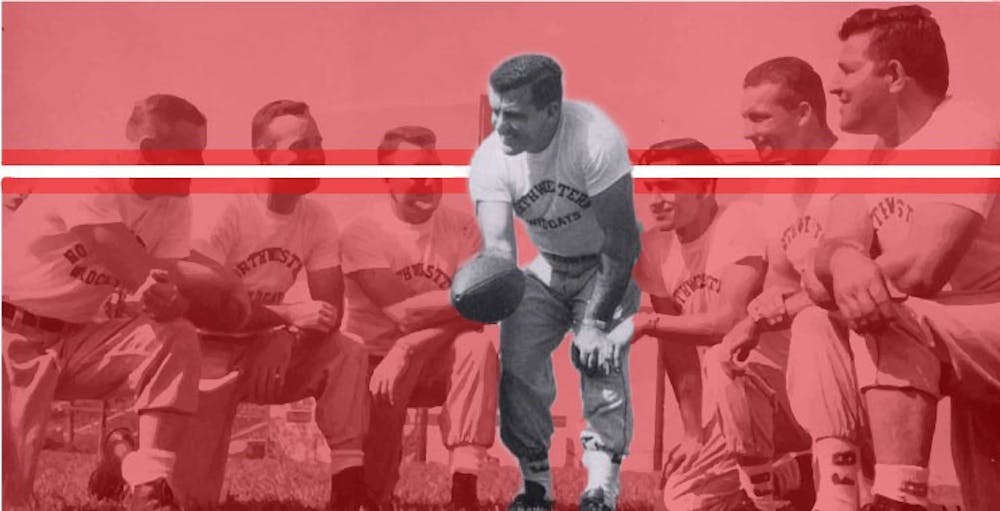Miami alumnus and renowned football coach Ara Parseghian died on Wednesday at the age of 94.
Best known for transforming the Fighting Irish from a declining program to a football powerhouse, the former Notre Dame coach of the 1960s and '70s was also a product of Miami's "Cradle of Coaches."
"I lost my childhood idol," said Chuck Martin, Miami's head football coach in a statement to Miami University on Wednesday. "Ara is one of the all-time greats of our profession."
Parseghian, a 1949 Miami graduate, played football for the RedHawks and earned All-Ohio honors in 1946 and 1947. He returned to his alma mater in 1950 and coached the team to two back-to-back Mid-American Conference Championships in 1954 and 1955, earning an esteemed spot in the university's Cradle of Coaches -- 10 former RedHawk football coaches who launched nationally recognized coaching careers at Miami.
Flowers adorned Parseghian's bronze statue in the south end zone at Yager Stadium, honoring the athlete, coach and advocate.
"I was inspired by his passion and character, especially his understanding of what makes a team," said Miami University President Gregory Crawford in Miami's statement. Crawford was dean of science at Notre Dame when he met Parseghian nearly a decade ago. "He always used his fist as a metaphor to show how strong individual members can be when they unite in loyalty and pursue a common purpose.
"Ara demonstrated amazing grace and leadership in life as well as on the football field," Crawford said in the statement.
Parseghian was born in Akron, Ohio, in 1923. His mother forbade him from trying out for his high school football team, though that didn't stop him. He served in the U.S. Navy for two years during World War II, playing football at the Great Lakes Naval Training Center under legendary coach Paul Brown, before playing as a halfback at Miami.
Parseghian graduated from Miami with a bachelor of science in education in 1949 and a master's of education in 1954. In addition to football, he also played varsity baseball and basketball at the university.
He was drafted 109th in the 13th round by the Pittsburgh Steelers during the 1947 National Football League Draft, and in 1948 he was selected 117th in the 25th round of the All-America Football Conference Draft by the Cleveland Browns. He played one season with the Browns before a hip injury ended his playing career, which led him to coach.
Parseghian served as an assistant coach at Miami to Woody Hayes in 1950, then became the head football coach in 1951 when Hayes left for Ohio State. The RedHawks went 39 wins-6 losses-2 ties (.859) under the tutelage of Parseghian.
After five seasons at Miami, Parseghian coached Northwestern to a record of 36-35-1 from 1955 to 1963. Notably, Parseghian's Northwestern team went 4-0 against Notre Dame.
Enjoy what you're reading?
Signup for our newsletter
Parseghian is tied for the best winning percentage of any coach who has faced the Irish at least four times in his career since the start of the 20th century.
In 1964, Notre Dame was no longer Parseghian's rival. It became his home for the next 11 years. Though criticized for a cautious strategy and lacking nerve, Parseghian boldly rearranged Notre Dame's team and transformed a losing bench into successful football players. He led the Fighting Irish to a record of 9-0-1 in 1966 and an undefeated record of 11-0-0 in 1973, earning Notre Dame's eighth and ninth National Championships.
"Among his many accomplishments, we will remember him above all as a teacher, leader and mentor who brought out the very best in his players, on and off the field," Notre Dame president Rev. John I. Jenkins said in a statement the university released Wednesday.
Parseghian retired from football in 1974 with a 95-17-4 (.836) record at Notre Dame and a career record of 170-58-6. He went on to be a color commentator for ABC Sports from 1975 to 1981 and then CBS Sports in 1988, also serving on Miami's Board of Trustees from 1978-1987.
During and after his coaching career, Parseghian was honored with a slew of awards and accolades. He was chosen as the national college coach of the year in 1964 by seven organizations, selected to be a member of the charter class of the Miami Athletic Hall of Fame in 1969, elected to the College Football Hall of Fame in 1975, given an honorary doctorate from Miami in 1978 and awarded an honorary degree from Notre Dame in 1997.
Crawford met Parseghian as a supporter of the Ara Parseghian Medical Research Foundation, which was founded in 1994 by Parseghian to finance research on Niemann-Pick Type C Disease (NPC), a genetic pediatric nerve disorder that killed three of Parseghian's grandchildren.
The foundation has raised more than $45 million to combat the disease.
"When I first started out, I wanted a silver bullet," Parseghian told the South Bend Tribune last year. "I wanted that cure that could help the children immediately. But research doesn't work that way. You've got to go step by step by step."
Perhaps that best summarizes Parseghian, as former players testify that he was not a motivator who cursed and broke clipboards on the sidelines but demanded the best from his players with just a look. He calmly stepped from university to university, creating successful football programs. He gracefully stepped from the life of an athlete to the life of a football coach, to the life of a fundraiser and advocate.
"He had a huge impact not only in football, where he won two national championships but in the lives of so many children and families afflicted by Niemann-Pick," Crawford said in the statement. "His virtuous leadership -- his confidence, his courage, his magnanimity -- inspire me, and I am honored to have been his friend."
In lieu of flowers, contributions can be made to the Ara Parseghian Medical Research Fund at Notre Dame.




